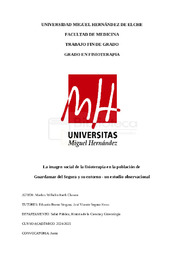Please use this identifier to cite or link to this item:
https://hdl.handle.net/11000/37441La imagen social de la fisioterapia en la población de Guardamar del Segura y su entorno. Un estudio observacional
| Title: La imagen social de la fisioterapia en la población de Guardamar del Segura y su entorno. Un estudio observacional |
| Authors: Barth Classen, Markus Wilhelm |
| Tutor: Bueno Vergara, Eduardo Segura Heras, José Vicente |
| Editor: Universidad Miguel Hernández |
| Department: Departamentos de la UMH::Salud Pública, Historia de la Ciencia y Ginecología Departamentos de la UMH::Estadística, Matemáticas e Informática |
| Issue Date: 2025-05-19 |
| URI: https://hdl.handle.net/11000/37441 |
| Abstract: Objetivo: Determinar diferencias entre grupos etarios en la imagen social de la fisioterapia en el año 2025 en Guardamar del Segura y su entorno. Material y método: Encuesta actitudinal anónima autoadministrada por Internet y análisis estadístico de los datos obtenidos. Se formularon 9 preguntas cerradas. Las preguntas abordaron uso, conocimientos y expectativas sobre fisioterapia, confianza en terapias y estereotipos. La difusión se realizó con la ayuda de entes locales. Resultados: El tamaño muestral fue de n=191. La muestra tuvo una distribución desequilibrada por edad y género. Las terapias manuales fueron el tratamiento más aplicado, seguido de electroterapia y punción seca. La mayoría de los encuestados relaciona la fisioterapia con lesiones deportivas, dolor de espalda y dolor de hombro. Hubo una valoración significativamente mejor del grupo de 24 a 35 años con respecto a la “preparación al parto”. La mayoría reconoció al fisioterapeuta como profesional sanitario, sin diferencias por edad. El factor más influyente en la elección del fisioterapeuta fue la especialización, seguido de recomendaciones de familiares y médicos. Los participantes identificaron el ejercicio terapéutico y las terapias manuales como las de mayor confianza. La necesidad de ecógrafo o el uso de terapias sin evidencia fueron los estereotipos que mostraron asociación con grupos etarios. La mayoría consideró importante que el fisioterapeuta le dedique tiempo a la educación. Discusión Los resultados de este estudio no confirman percepciones ampliamente erróneas, aunque se detectan sesgos puntuales. Los resultados coinciden con Sheppard en la alta valoración del ejercicio terapéutico, aunque se observa que tiene poca presencia en la clínica. Los participantes le dan mucha importancia a la educación. La especialización es el criterio más decisivo al elegir fisioterapeuta. Objectives: The detection of differences between age groups in the social image of physiotherapy in 2025 in Guardamar del Segura and surrounding areas. Materials and Methods: An anonymous, self-administered online attitudinal survey comprising 9 closed-ended questions were used together with statistical analysis of the collected data. The use, knowledge and expectations of physiotherapy, trust in therapies, and stereotypes were subjects of the questionaire. The survey was distributed with the support of local organizations. Results: The sample size was n = 191. Age and gender were unevenly distributed. Manual therapy was the most commonly applied treatment, followed by electrotherapy and dry needling. Most participants associated physiotherapy with sports injuries, back pain, and shoulder pain. Participants aged 25 to 34 rated "childbirth preparation" significantly higher. Most classified physiotherapists as healthcare professionals. The most important factor for choosing a physiotherapist was specialization, followed by recommendations from family, friends and doctors. Participants rated therapeutic exercise and manual therapy as the most trusted treatments. The importance of ultrasound equipment and the use of non-evidence-based therapies were the stereotypes that showed associations with age groups. For most participants the dedication of enough time to education was important. Discussion: The results of this study do not reveal widespread misconceptions, although some specific biases were observed. The findings are in alignment with Sheppard findings concerning the importance of therapeutic exercise perceived by patients, in spite of its limited presence in the clinic. Receiving information is an important factor for patients. Specialization was the most decisive factor in selecting a physiotherapist. |
| Keywords/Subjects: physiotherapy social image perception bias age groups |
| Knowledge area: CDU: Ciencias aplicadas |
| Type of document: info:eu-repo/semantics/bachelorThesis |
| Access rights: info:eu-repo/semantics/openAccess Attribution-NonCommercial-NoDerivatives 4.0 Internacional |
| Appears in Collections: TFG - Fisioterapia |
.png)

